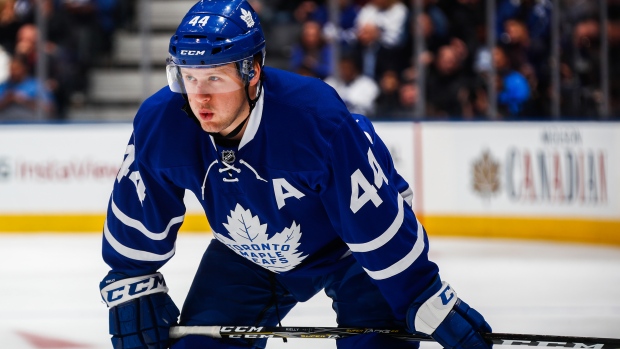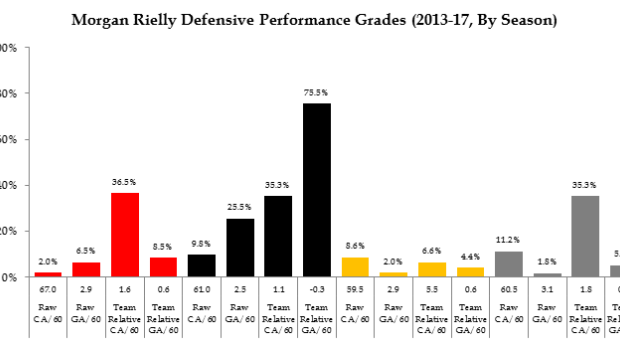Feb 20, 2017
Rielly and the future of the Leafs’ defence
Toronto blueliner has been the biggest enigma for team during transition into the Mike Babcock era, Travis Yost writes.
By Travis Yost

The Toronto Maple Leafs have taken an impressive step forward in their second year under Mike Babcock. Even after dropping six of their last 10 games, the team is still legitimately in the playoff race. That’s thanks in part to the points they banked earlier in the season, as well as the fact that the Atlantic Division is a muddied mess.
Babcock has surely been frustrated with his team of late. How could he not be? The Leafs have devolved from high-tempo, high-risk, high-reward team to one that makes too many errors in the defensive zone. Even with an impressive season from Frederik Andersen in net, the Leafs have slid down to 28th in goals against at 5-on-5 – thanks largely to the volume of chances they are giving up.
Coming into the season, there weren’t exactly heightened expectations for the team’s young blueline. Outside of Jake Gardiner, who at this point is an established NHL veteran and rock-solid top-four guy, there wasn’t a whole lot to work with. The team was hoping that veteran guys like Roman Polak and Matt Hunwick would provide some poise, while younger players like Morgan Rielly, Nikita Zaitsev, and Connor Carrick would take big steps forward.
I mention Rielly in that group because, quite truthfully, he’s been the biggest enigma for this Leafs team as they’ve transitioned into the Babcock era. Rielly’s been billed as the next big thing for some time now. When you have his skating and puck-moving prowess, you generally have the ingredients for a first-pairing defender.
But Rielly hasn’t followed the Erik Karlsson, Drew Doughty, or P.K. Subban path of development here. He’s consistently struggled when forced into the defensive zone, and not only has that limited his efficacy, but it’s added yet another question about what the long-term outlook for this Leafs defence looks like.
The big problem here is that Rielly isn’t a rookie. This is now year four of Rielly struggling to slow down the opposition’s attack.
To illustrate this, I’ve pulled out the 138 defenders who have played regular minutes over the last four years. The graph below shows Rielly’s rank against all other defenders on four metrics – raw shot and goal prevention, and team-relative shot and goal prevention. As you can see, it’s pretty much all bad.

Again, the percentage is how many defenders Rielly would grade out better than in a specific key defensive metric. So, he’s been better than about 2.9 per cent of defenders league-wide in preventing shots, 0.7 per cent in preventing goals, and so on. This is based on his score over that four-year window, noted across the horizontal axis. (He gives up 61.83 shots per 60 minutes; he gives up 2.82 goals against per 60-minutes, etc.)
Rielly isn’t as much an offensive defenceman as he is a one-dimensional defenceman. And I think there’s an important distinction between the two. He’s played with a number of partners at this point and in varying difficult minutes – this year, for just one example, he’s on the ice for about 44 per cent of Toronto’s 5-on-5 defensive zone starts, which is usually a sign of a guy getting pushed into tougher minutes.
Would that completely excuse these numbers? I don’t think so. Guys like Justin Braun and Doughty have seen an almost identical percentage there, and both have obviously played much better in the defensive third.
Now, maybe you look at the above graph and think it’s unfair. After all, if Rielly was truly terrible for only portions of this run and had since improved, a four-year average wouldn’t exactly show that. So let’s look at the same four performance metrics on a year-by-year basis. That, unfortunately, kills the notion that there’s been a sense of improvement here (click to enlarge):

Outside of that 2014-15 season where Rielly just played really low-event hockey (primarily paired with Roman Polak, the unit struggled to score but improved on the goals-against front), he’s been just a massive net negative for the Leafs defensively. And that’s been emphatically true over the last two seasons.
At the end of the day, if you’re a Leafs executive, this is something you have to prioritize and figure out. It’s reasonably clear to me that Rielly’s not going to be a shutdown defender anytime soon, but his offensive skill is so palpable that cutting his minutes – especially in light of the alternatives, which are weak right now – is unacceptable.
It’s one of the big reasons why I think the Leafs need to be active on the trade front, whether it’s at the deadline or during the off-season. Finding a true top-four type to smooth over Rielly’s deficiencies could yield big gains for this team – a team that’s desperately in need of clearing up goals-against issues.
We have seen other defenders benefit from this type of relationship (Jake Muzzin for Doughty; Marc Methot for Karlsson), and it could be the key that unlocks the next level of evolution from a Leafs team still on the rise.


